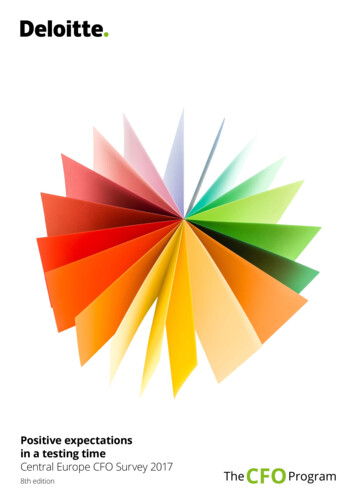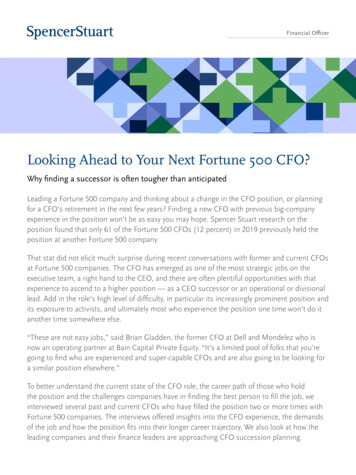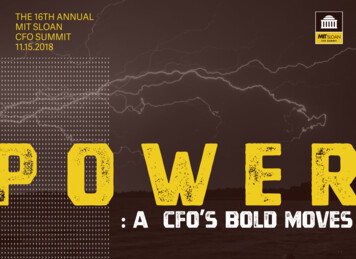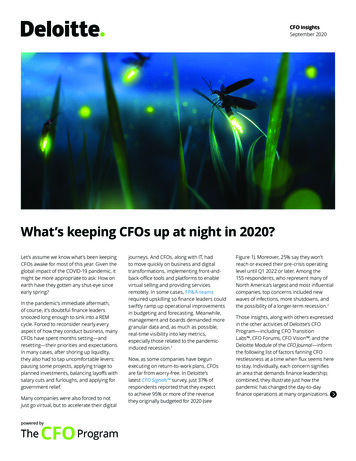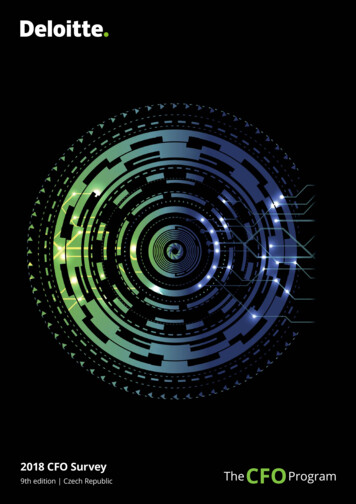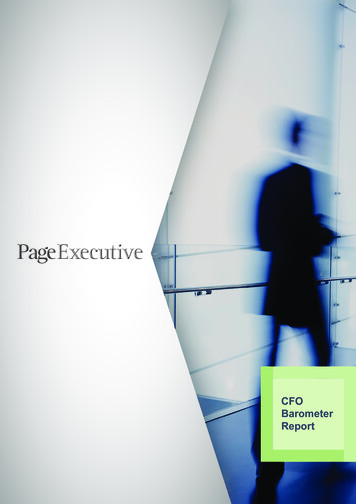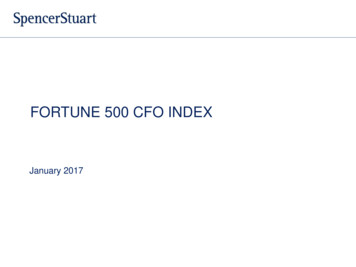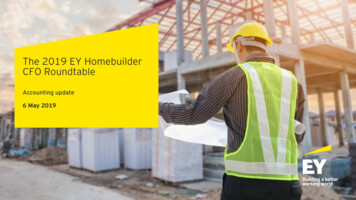
Transcription
The 2019 EY HomebuilderCFO RoundtableAccounting update6 May 2019
Disclaimer EY refers to the global organization, and may refer to one or more, of the member firms of Ernst & Young GlobalLimited, each of which is a separate legal entity. Ernst & Young LLP is a client-serving member firm of Ernst & YoungGlobal Limited operating in the US. This presentation is 2019 Ernst & Young LLP. All rights reserved. No part of this document may be reproduced,transmitted or otherwise distributed in any form or by any means, electronic or mechanical, including byphotocopying, facsimile transmission, recording, rekeying, or using any information storage and retrieval system,without written permission from Ernst & Young LLP. Any reproduction, transmission or distribution of this form orany of the material herein is prohibited and is in violation of US and international law. Ernst & Young LLP expresslydisclaims any liability in connection with use of this presentation or its contents by any third party. Views expressed in this presentation are those of the speakers and do not necessarily represent the views ofErnst & Young LLP. This presentation is provided solely for the purpose of enhancing knowledge on tax matters. It does not provide taxadvice to any taxpayer because it does not take into account any specific taxpayer’s facts and circumstances. These slides are for educational purposes only and are not intended, and should not be relied upon, as accountingadvice. Neither EY nor any member firm thereof shall bear any responsibility whatsoever for the content, accuracy, orsecurity of any third-party websites that are linked (by way of hyperlink or otherwise) in this presentation.Page 2The 2019 EY Homebuilder CFO Roundtable 6 May 2019 Four Seasons Hotel Las Vegas
Accounting updateVeronica VrosErnst & Young LLPPage 3Jeff WhittonErnst & Young LLPThe 2019 EY Homebuilder CFO Roundtable 6 May 2019 Four Seasons Hotel Las Vegas
AgendaASC 606 revenue recognition implementation considerations for private companies1.Starting the implementation process2.Tax considerations3.Challenging accounting areas4.EY tools and resourcesHow the new leases standard affects real estate entitiesPage 4The 2019 EY Homebuilder CFO Roundtable 6 May 2019 Four Seasons Hotel Las Vegas
ASC 606 revenuerecognitionimplementationconsiderations forprivate companiesPage 5The 2019 EY Homebuilder CFO Roundtable 6 May 2019 Four Seasons Hotel Las Vegas
Starting theimplementation processPage 6The 2019 EY Homebuilder CFO Roundtable 6 May 2019 Four Seasons Hotel Las Vegas
Starting the implementation processLessons learned from implementation experienceRegardless of expected changes, private companiesneed to start the implementation process early Complying with the new requirements often requires more effort than originally expected: Establishing a cross-functional team and determining training needs is a good place to start Effort can still be substantial even if no material effect from adoptionMay be difficult to manage ASC 606 adoption with regular responsibilitiesThere are risks (e.g., contract initiation, disclosures, estimates) to consider and address, even if nomaterial effect from adoptionInvolve others outside of accounting (e.g., sales, legal, operations, tax, IT)Understanding the new disclosures is important because significantly more recurringdisclosures are required than under current GAAPCoordinating with auditors leads to a more efficient audit approachPage 7The 2019 EY Homebuilder CFO Roundtable 6 May 2019 Four Seasons Hotel Las Vegas
Starting the implementation processKey questions to consider Questions to consider when getting started: How will the new standard affect the timing and measurement of the company’s revenuerecognition?What are the new disclosure requirements?How will the company’s processes be affected?How long is the implementation going to take?From our implementation experience, the standard is too complex to take a high-levelapproach.Most entities have too many contracts with customers to analyze each contract individually.Page 8The 2019 EY Homebuilder CFO Roundtable 6 May 2019 Four Seasons Hotel Las Vegas
Starting the implementation processRevenue recognition effect on select sectorsOil and als andbiotechnologyProfessionalservice providersMedia ngineeringTechnologyAirlinesAutomotiveReal estateHospitalityConsumer productsHealthBanking and insuranceLess impactPage 9Considerable impactThe 2019 EY Homebuilder CFO Roundtable 6 May 2019 Four Seasons Hotel Las Vegas
Tax considerationsPage 10The 2019 EY Homebuilder CFO Roundtable 6 May 2019 Four Seasons Hotel Las Vegas
Book and tax differences in revenueComparison of core principlesCore principle: recognize revenue to depict the transfer of promised goods or services to customers in an amount thatreflects the consideration to which the entity expects to be entitled in exchange for those goods or servicesBookIdentify the contract(s)with a customerStep 1TaxIdentify the separateperformanceobligations in thecontract(s)Step 2Identify income streams andunderlying contractsDetermine thetransaction priceAllocate transactionprice to the separateperformanceobligations inthe contract(s)Step 3Confirm the amount ofincome that can bedetermined withreasonable accuracyStep 4Determine when thecompany has a fixedright to the income –either when earned,due or receivedRecognize revenuewhen or as entitysatisfies aperformanceobligationStep 5Consider specialrules that changethe timing of incomerecognitionCore principle: recognize income at the earlier of when all events have occurred to earn the revenue orwhen the company is entitled to the revenuePage 11The 2019 EY Homebuilder CFO Roundtable 6 May 2019 Four Seasons Hotel Las Vegas
Challenging accountingareasPage 12The 2019 EY Homebuilder CFO Roundtable 6 May 2019 Four Seasons Hotel Las Vegas
Challenging accounting areasTop 10 based on our implementation experienceContract duration Contract provisions (e.g., termination provisions) and their effect oncontract durationIdentifying performanceobligations Determining if identified promises of goods and services should becombined into a single performance obligation Determining nature of the company’s promise by identifying the specifiedgood or service (i.e., unit of account) and assessing if the companycontrols the specified good or service prior to transfer to customer Distinguishing between a contract that includes customer options topurchase additional goods and services and one that includes variableconsideration based on variable quantity (e.g., usage-based fee) Constraining the estimate of variable consideration (i.e., not defaulting toconstraining to zero)Principal vs. agentCustomer optionsVariable considerationPage 13The 2019 EY Homebuilder CFO Roundtable 6 May 2019 Four Seasons Hotel Las Vegas
Challenging accounting areasTop 10 based on our implementation experience (cont.) Determining whether a company meets the criteria to apply the variableconsideration allocation exception (e.g., whether the terms of a variablepayment relate specifically to the company’s efforts to satisfy aperformance obligation)Residual method Determining whether the historical selling price is highly variableSatisfied over time vs.point in time Determining whether control of goods and services is transferred overtime or at a point in timeContract costs — obtain Determining whether contract acquisition costs are incremental and if thecompany expects to recover Determining whether costs generate or enhance resources of thecompany that will be used in satisfying performance obligations in thefuture (i.e., second fulfillment criterion)Variable considerationallocation exceptionContract costs — fulfillPage 14The 2019 EY Homebuilder CFO Roundtable 6 May 2019 Four Seasons Hotel Las Vegas
EY tools and resourcesPage 15The 2019 EY Homebuilder CFO Roundtable 6 May 2019 Four Seasons Hotel Las Vegas
EY tools and resources Scoping revenue streams Contract reviews Revenue stream scoping questionnaireContract analysis enablerAccounting guidance, examples and FAQs Private Company Reporting Update: “How the new revenue standard will affect private companies”EY Financial Reporting Development Publication: “Revenue from Contracts with Customers” Page 16See Appendix E for example disclosure checklist for nonpublic entitiesTechnical Line: “Common challenges in implementing the new revenue recognition standard”Technical Line: “How the new revenue standard may affect a company’s income tax accounting”EY industry publicationsThe 2019 EY Homebuilder CFO Roundtable 6 May 2019 Four Seasons Hotel Las Vegas
How the new leasesstandard affectsreal estate entitiesPage 17The 2019 EY Homebuilder CFO Roundtable 6 May 2019 Four Seasons Hotel Las Vegas
New leases standardOverview The new leases standard from the Financial Accounting Standards Board (FASB) requireslessees to recognize assets and liabilities for most leases (including operating leases) butrecognize expenses in a manner similar to today’s accounting.For lessors, the new guidance modifies the lease classification criteria and leverages certainguidance in the new revenue recognition standard.The new leases guidance eliminates today’s real estate-specific provisions, changes sale andleaseback accounting and eliminates leveraged lease accounting prospectively.The effect on financial statements, business processes and internal controls will likely besignificant for some entities.Effective date: Page 18Public business entities (PBEs) and certain not-for-profit entities and employee benefit plans —annual periods beginning after 15 December 2018, and interim periods within those yearsAll other entities — annual periods beginning after 15 December 2019, and interim periods thefollowing yearEarly adoption permitted for all entitiesThe 2019 EY Homebuilder CFO Roundtable 6 May 2019 Four Seasons Hotel Las Vegas
New leases standardScope and scope exceptionsThe guidance applies to: Leases of property, plant and equipmentThe guidance does not apply to: Leases of inventory, intangible assets, assets under construction and biological assets,including timberLeases to explore for or use minerals, oil, natural gas and similar non-regenerativeresources: Leases of equipment used to explore for natural resources are not part of this scope exception(i.e., they are in the scope of Accounting Standards Codification (ASC) 842)Arrangements in the scope of ASC 853, Service Concession ArrangementsA lease is a contract, or part of a contract, that conveys the right to control the use of identifiedproperty, plant or equipment (an identified asset) for a period of time in exchange for consideration.Page 19The 2019 EY Homebuilder CFO Roundtable 6 May 2019 Four Seasons Hotel Las Vegas
New leases standardDetermining whether an arrangement contains a leaseNoIs there an identified asset?YesDoes the customer have the right to obtain substantially all of theeconomic benefits from the use of the assetthroughout the period of use?YesCustomerYesYesSupplierDoes the customer or supplier have the right to direct how and for what purposethe identified asset is used throughout the period of use?Neither; how and for what purpose the asset willbe used are predeterminedDoes the customer have the right to operate the asset throughout the period of use withoutthe supplier having the right to change those operating instructions?NoDid the customer design the asset (or specific aspects of the asset)in a way that predetermines how and for what purposethe asset will be used throughout the period of use?The contract contains a leasePage 20NoNoThe contract does notcontain a leaseThe 2019 EY Homebuilder CFO Roundtable 6 May 2019 Four Seasons Hotel Las VegasNo
New leases standardIdentifying and separating lease and non-lease components Many contracts contain a lease coupled with an agreement to purchase or sell other goods orservices (non-lease components). Non-lease components (e.g., maintenance activities, including common area maintenance) areidentified and accounted for separately from the lease component in accordance with other USGAAP.Some contracts contain items that do not relate to the transfer of goods or services by thelessor to the lessee (e.g., fees or other administrative costs that a lessor charges a lessee,payments for insurance that protects the lessor’s asset, taxes related to the lessor’s asset). Page 21These items should not be considered separate components.Lessees and lessors do not allocate consideration in the contract to these items.The 2019 EY Homebuilder CFO Roundtable 6 May 2019 Four Seasons Hotel Las Vegas
New leases standardIdentifying and separating lease and non-lease components (cont.) Lessees can make an accounting policy election (by class of underlying asset) to account foreach separate lease component of a contract and its associated non-lease components as asingle lease component.The FASB added an optional practical expedient that allows lessors to elect(by class of underlying asset) to not separate lease and related non-lease components if thenon-lease components otherwise would be accounted forin accordance with the new revenue standard and both of the following criteria are met: The timing and pattern of transfer of the lease component and the associated non-leasecomponent(s) are the same.The lease component would be classified as an operating lease if it were accounted for separately.If both of the criteria are met and a lessor elects to use the practical expedient, the lessor isrequired to account for the combined component as a single performance obligation inaccordance with ASC 606 if the non-lease component is the predominant component. Page 22If the non-lease component is not the predominant component, the lessor accounts for thecombined component as an operating lease.The 2019 EY Homebuilder CFO Roundtable 6 May 2019 Four Seasons Hotel Las Vegas
New leases standardLease term and purchase optionsLease termAny noncancelable periods Periods covered by an option to terminate the lease if the lessee isreasonably certain not to exercise that optionPeriods covered by an option to extend (or not terminate) the leasein which the exercise of the option is controlled by the lessorThe FASB said that “reasonably certain” has the same meaning as “reasonably assured” in ASC 840. Periods covered by an option to extend the leaseif the lessee is reasonably certain to exercise that optionReasonably certain is generally interpreted as a high threshold.Purchase options should be assessed in the same way as options to extend the lease term or terminatethe lease.Page 23The 2019 EY Homebuilder CFO Roundtable 6 May 2019 Four Seasons Hotel Las VegasOverview of the new leases standard
New leases standardLease payments Lease payments should be consistent with the lease term.Lease paymentsFixed (includingin-substancefixed) payments,less any leaseincentives paidor payable to thelesseeVariablepaymentsbased on anindex or rateExercise price ofa purchaseoption*Payments forpenalties forterminating thelease**Amounts it isprobable thatthe lessee willowe underresidual valueguarantees(lessees only)* Include only if reasonably certain of exercise** Include only if the lease term reflects the lessee exercising an option to terminate the lease Lease payments also include fees paid by the lessee to the owners of aspecial-purpose entity for structuring a transaction. Page 24However, such fees are excluded from the fair value of the underlying asset forpurposes of the leases classification test.The 2019 EY Homebuilder CFO Roundtable 6 May 2019 Four Seasons Hotel Las VegasOverview of the new leases standard
New leases standardDiscount rates The discount rate for the lease is the “rate implicit in the lease.” Page 25When the rate implicit in the lease cannot be readily determined, lessees use their incrementalborrowing rate (i.e., the rate of interest that the lessee would have to pay to borrow on acollateralized basis over a similar term an amount equal to the lease payments in a similareconomic environment).For purposes of determining a lessee’s incremental borrowing rate, a collateralized borrowingshould also assume the lender can seek recourse through other assets of the lessee borrower. A lessee should start with the general credit of the company and then adjust the rate to reflect the impacton collateral to the incremental borrowing rate. However, the borrowing cannot be overcollateralized.In some cases, this rate may be the parent’s incremental borrowing rate.Lessees that are not PBEs are permitted to make an accounting policy election (for all leases) to usea risk-free rate determined using a period comparable with the lease term for initial and subsequentmeasurement of lease liabilities.This policy election must be disclosed in the notes to the financial statements.The 2019 EY Homebuilder CFO Roundtable 6 May 2019 Four Seasons Hotel Las Vegas
New leases standardInitial direct costs (IDCs) Only incremental costs qualify as IDCs. Incremental costs are those that would not have been incurred if the lease had not been obtained(e.g., commissions, payments made to an existing tenant to incentivize that tenant to terminate itslease).Lease classificationLesseesOperating leaseInclude IDCs in the initial and subsequent measurement of theright-of-use (ROU) assetFinance leaseSales-type lease if the fair value of the underlying asset isdifferent from its carrying amount at lease commencementLessors*Sales-type lease if the fair value equals the carrying value of theunderlying asset at lease commencementDirect financing leaseOperating leaseAccounting for capitalized IDCsExpense IDCs at lease commencementInclude IDCs in the initial and subsequent measurement of the netinvestment in the leaseRecognize IDCs as an expense over the lease term on the samebasis as lease income* For purposes of performing the sales-type lease classification test only, a lessor assumes that no IDCs will be deferred (i.e., IDCs are excluded from thecalculation of the rate implicit in the lease) if, at the commencement date, the fair value of the underlying asset is different from its carrying amount.Page 26The 2019 EY Homebuilder CFO Roundtable 6 May 2019 Four Seasons Hotel Las Vegas
New leases standardCriteria for lease classification — lesseesAt the commencement date, a lease is a finance leaseif it meets any one of the criteria below; otherwise, the lease is an operating lease. The lease transfers ownership of the underlying asset to the lessee by the end of the lease term.The lease grants the lessee an option to purchase the underlying asset that the lessee is reasonablycertain to exercise.The lease term is for the major part of the remaining economic life of the underlying asset.*The present value of the sum of the lease payments and any residual value guaranteed by the lesseethat is not already reflected in the lease payments equals or exceeds substantially all of the fair valueof the underlying asset.The underlying asset is of such a specialized nature that it is expected to have no alternative use tothe lessor at the end of the lease term.* Not applicable for leases that commence at or near the end of the underlying asset’s economic lifePage 27The 2019 EY Homebuilder CFO Roundtable 6 May 2019 Four Seasons Hotel Las VegasOverview of the new leases standard
New leases standardLessee accounting — presentationBalance sheetROU asset Page 28Lease liabilityPresent either separately or together withother assets (e.g., owned assets)If presented together with other assets, discloseline items that include ROU assets and theiramountsFinance lease ROU assets must be presentedseparately from operating lease ROU assetsSubject to same classification as othernonfinancial assets Present either separately or together with otherliabilitiesIf presented together with other liabilities,disclose the line items that include leaseliabilities and their amountsFinance lease liabilities must be presentedseparately from operating lease liabilitiesSubject to current and noncurrentclassification, similar to other financialliabilitiesThe 2019 EY Homebuilder CFO Roundtable 6 May 2019 Four Seasons Hotel Las Vegas
New leases standardLessee accounting — presentation (cont.)IncomestatementPresent lease-related amortization and lease-related interest expense in amanner consistent with how the entity presents depreciation or amortization ofsimilar assets and other interest expense* Include lease expense in income from continuing operations Present principal payments within financing activitiesPresent interest payments in accordance with ASC 230, Statement of Cash FlowsFinance leasesOperating leasesFinance leasesStatementof cash flows Present all payments within operating activities, except for payments thatrepresent costs to bring another asset to the condition and location necessaryfor its intended use (investing activities) Present lease payments for short-term leases and variable lease payments (notincluded in the lease liability) within operating activitiesMake supplemental noncash disclosuresOperating leasesAll lease types * The general expectation is variable lease costs are most appropriately presented as interest expense.Page 29The 2019 EY Homebuilder CFO Roundtable 6 May 2019 Four Seasons Hotel Las VegasOverview of the new leases standard
New leases standardReal estate considerations — sale and leaseback transactions ASC 842 also eliminates ASC 840’s realestate-specific guidance for sale andleaseback transactions involving real estate,including ASC 840’s requirement that theseller-lessee evaluate whether the sale of realestate satisfies the criteria of ASC 360-20,Real Estate Sales.Both the seller-lessee and the buyer-lessorare required to apply ASC 842 and certainprovisions of ASC 606 to determine whetherto account for a sale and leasebacktransaction as a sale (seller-lessee) andpurchase (buyer-lessor) of an asset.Page 30It is likely that more sale and leasebacktransactions involving real estate to beaccounted for as sales and subsequentleasebacks under the new standard thanunder ASC 840’s guidance.The 2019 EY Homebuilder CFO Roundtable 6 May 2019 Four Seasons Hotel Las Vegas
New leases standardReal estate considerations — sale and leaseback transactions (cont.)Is the transaction a sale under ASC 606*(i.e., does it transfer control of the asset to the buyer-lessor)?No* Excluding the evaluation of the repurchase option under ASC 606, as the repurchase option is subject to theevaluation under ASC 842 (see below)YesIs the leaseback classified as a sales-type lease by the buyer-lessoror a finance lease by the seller-lessee?YesNoNoDoes the transaction include an option for the seller-lessee torepurchase the asset?YesYesDoes the repurchase option meet both of the following conditions? The exercise price of the option is the fair value of the underlying asset at the time the option is exercised. Alternative assets that are substantially the same as the transferred asset are readily available in themarketplace.Account for as a sale andleaseback transaction by boththe lessee and lessorPage 31Account for as a financingtransaction (i.e., a failed sale)by both the lessee and lessorThe 2019 EY Homebuilder CFO Roundtable 6 May 2019 Four Seasons Hotel Las VegasNo
New leases standardReal estate considerations — sale and leaseback transactions (cont.)Seller-lesseeBuyer-lessorSale and leaseback transaction accounting Accounting for the sale: Recognize the transaction price for the sale in accordance with theguidance on determining the transaction price in ASC 606 at thepoint in time that the buyer-lessor obtains control of the asset Derecognize the carrying amount of the underlying asset Recognize any gain or loss, adjusted for off-market terms,immediatelyAccounting for the purchase: Account for the asset in accordance with ASC 360Accounting for the leaseback: Account for it in the same manner as any otherlease, adjusted for off-market termsAccounting for the leaseback: Account for it in the same manner as any other lease, adjusted foroff-market termsAdditional disclosures are requiredFinancing transaction (i.e., failed sale) accounting Keep the asset on the balance sheet Do not recognize the transferred asset Account for amounts received as a financial liability Account for amounts paid as a receivablePage 32The 2019 EY Homebuilder CFO Roundtable 6 May 2019 Four Seasons Hotel Las Vegas
New leases standardDisclosure Disclosure objective: to enable financial statement users to assess the amount, timing anduncertainty of cash flows arising from leasesNew disclosures for lessees and lessors include: New disclosures for lessees include: Significant assumptions and judgments madeMaturity analyses of lease liabilities (for lessees) or lease receivables (for lessors), separately bylease type, as of the reporting date, including a reconciliation of undiscounted cash flows to thelease liabilities or receivablesSeparate quantitative disclosure of lease cost, by type (e.g., finance lease, operating lease, shortterm lease)Weighted-average remaining lease term, separately by lease typeWeighted-average discount rate, separately by lease typeNew disclosures for lessors include: Page 33Information about management of risks related to residual values of leased assetsFor sales-type and direct financing leases, explanations of significant changes in balance ofunguaranteed residual assetsTable of lease income recognized in each annual and interim reporting periodThe 2019 EY Homebuilder CFO Roundtable 6 May 2019 Four Seasons Hotel Las Vegas
New leases standardPractical expedients The following practical expedients can be elected by an entity separately or in anycombination: An entity can elect to apply a package of practical expedients that allows it not to reassess:Whether contracts areor contain leasesLease classificationWhether IDCs qualify forcapitalizationMust be elected as a package and applied to all expired and existing leases An entity can make an election for all existing leases to use hindsight when determining the leaseterm (i.e., evaluating a lessee’s option to renew or terminate the lease or to purchase the underlyingasset) and assessing impairment of ROU assets (lessees only).An entity can make an election to continue applying its current accounting policy for all landeasements that exist or expire before ASC 842’s effective date.An entity is required to disclose which of the practical expedients it elected to apply.Page 34The 2019 EY Homebuilder CFO Roundtable 6 May 2019 Four Seasons Hotel Las Vegas
Questions?Page 35The 2019 EY Homebuilder CFO Roundtable 6 May 2019 Four Seasons Hotel Las Vegas
EY Assurance Tax Transactions AdvisoryAbout EYEY is a global leader in assurance, tax, transaction andadvisory services. The insights and quality services wedeliver help build trust and confidence in the capital marketsand in economies the world over. We develop outstandingleaders who team to deliver on our promises to all of ourstakeholders. In so doing, we play a critical role in building abetter working world for our people, for our clients and forour communities.EY refers to the global organization, and may refer to one ormore, of the member firms of Ernst & Young Global Limited,each of which is a separate legal entity. Ernst & YoungGlobal Limited, a UK company limited by guarantee, does notprovide services to clients. Information about how EYcollects and uses personal data and a description of therights individuals have under data protection legislation areavailable via ey.com/privacy. For more information aboutour organization, please visit ey.com. 2019 Ernst & Young LLP.All Rights Reserved.US SCORE no. 06147-191USBSC no. 1901-3011954ED NoneThis material has been prepared for general informational purposesonly and is not intended to be relied upon as accounting, tax or otherprofessional advice. Please refer to your advisors for specific advice.ey.com
The new leases standard from the Financial Accounting Standards Board (FASB) requires lessees to recognize assets and liabilities for most leases (including operating leases) but recognize expenses in a manner similar to today's accounting.



